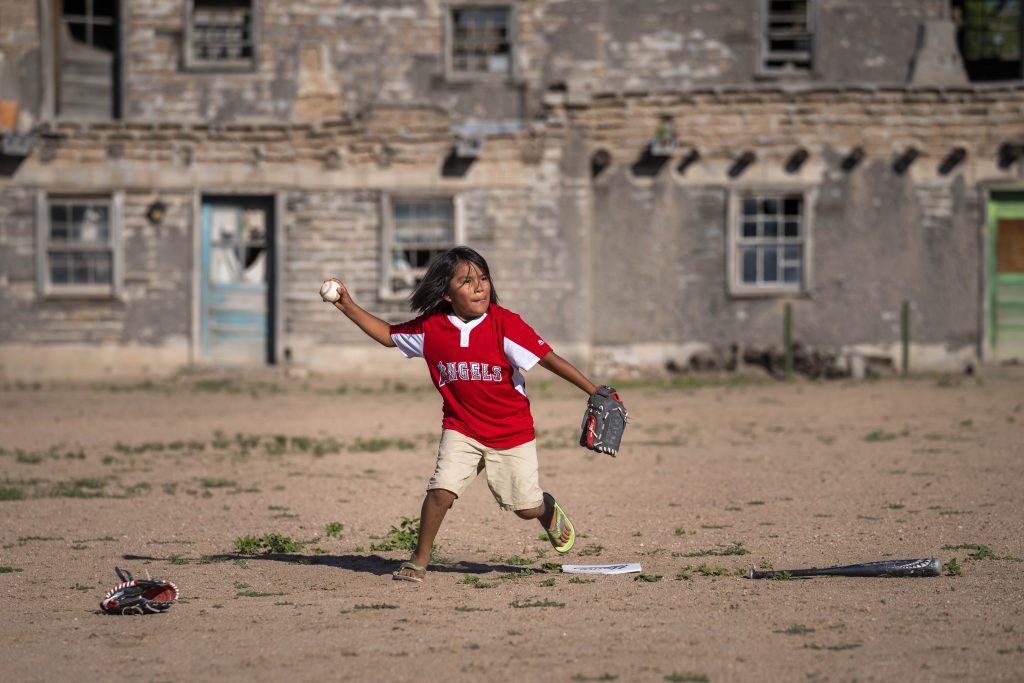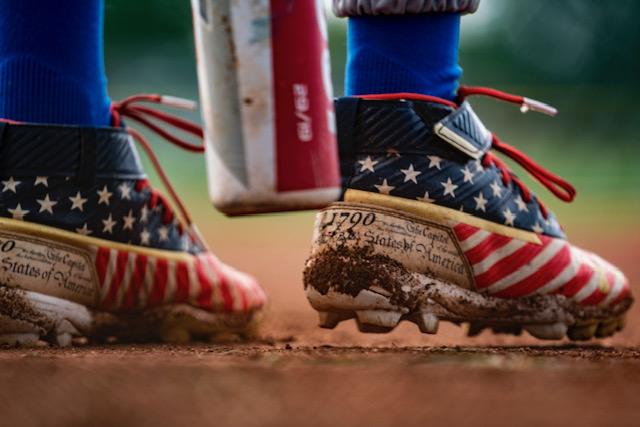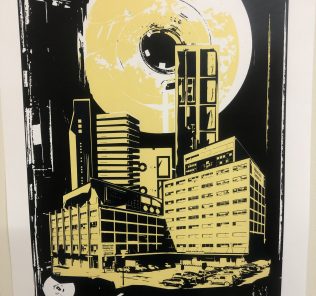Grassroots Baseball on Route 66: The game goes on forever

A Tesuque Pueblo player during a pickup game on July 4, 2021 at the Pueblo in Santa Fe, NM. The Tesuques play in the All Indian League, an adult baseball league that includes pueblos across New Mexico. (Courtesy of Jean Fruth)
Grassroots baseball players have always been highway gypsies.
They travel from diamond to diamond with jewels of their trade: bats that are needles of a mystic compass, gloves that try to catch all that goes by, and cleats that are as down and dirty as road tires. And when the journey is realized, the gypsy is safe at home.
The new Jean Fruth book “Grassroots Baseball: Route 66” accomplishes two remarkable things. It honors the meaning of home while celebrating the spirit of travel across America.
The hardcover 256-page “Grassroots Baseball: Route 66” is a collaboration between photographer Fruth and Jeff Idelson, former president of the National Baseball Hall of Fame and Museum in Cooperstown, N.Y. There are also landscape memory essays from Baseball Hall of Famer Johnny Bench, Baseball Hall of Famer Jim Thome (the nicest guy in professional baseball) future baseball commissioner Mike Veeck and others.
The book retails for $70. Net proceeds support the non-profit Grassroots Baseball mission to promote and celebrate the amateur game around the globe with a focus on growing interest and participation at the youngest levels. (Visit Grassroots Baseball.)

Fruth and Idelson are in Chicago this week. They will be signing the book with Mike Veeck (co-owner of the St. Paul saints and co-founder of Fun is Good, an employee engagement consulting firm) from 6-9 p.m. Sept. 15 at August House Studio, 2113 W. Roscoe.
The art studio is owned and operated by Veeck’s sister Marya. The Grassroots photo exhibit will be up through Sept. 30. This will be a lot of fun. The Veecks are like family to me. And no one will be playing Bee Gees records.
I love baseball—maybe grassroots/minor league baseball more than mechanical major league baseball these days—and I traveled the entire 2,448 miles of Route 66 in 1991. Fruth gifts 235 vivid color images in her book and they drive the reader directly into the heart of America.
Any Route 66 pilgrim knows to never dismiss the 13 miles of Route 66 in Kansas. That happened once when I was on the rickety Asleep at the Wheel “Route 66” tour bus and driver-bandleader Ray Benson was in a hurry to get to Tulsa, Ok. He blew off Kansas and never heard the end of it from Kansas road fans. But Fruth double trucks a Kansas field at sunset with an amateur player wearing shoes adorned with the U.S. Constitution. The imagery is elegant.

A Jackie Robinson West player turns the corner during a Little League game against the New Lenox Rebels, May 05, 2019 in New Lenox, Il. (Courtesy of Jean Fruth)
Ted Drewes Frozen Custard on Route 66 in St. Louis can be viewed as a Route 66 cliche, but not in Fruth’s eyes. She captured five players from an American Legion game sitting in front of the ice cream stand enjoying a post-game snack. Former Philadelphia Phillies first baseman Ryan Howard wrote the detailed essay that accompanies the Missouri section of the book.
Howard grew up in Wildwood, a suburb of St. Louis, and attended Missouri State University in Springfield. “One of the good things that came out of COVID was that the legends who participate in the book had time on their hands and wrote their essays early in the process,” Fruth said earlier this week. “This allowed me to learn what in their communities was important to them while being raised. I used that as a road map for making pictures. For Ryan, one of those experiences was going to Ted Drewes for ice cream as a Little Leaguer.”

Route 66, St. Louis (Courtesy of Jean Fruth,
Fruth and Idelson drove their RV to Ted Drewes and they saw grassroots teams there just as Howard described from 40 years ago. “When we were gathering the Little Leaguers for the photo, Jeff notice that one of the kids had the name ‘Hrabosky’ on the back of his uniform,” Fruth recalled. “He asked the young man if he was related to ‘The Mad Hungarian’ (the celebrated 1970s St. Louis Cardinal relief pitcher), to which he said, ‘Why, he’s my grandfather.’ I love how baseball can connect generations, even when you least expect it.”
I kind of love how that story makes me feel old.
I got to know Fruth and Idelson when they were on my WGN-AM radio show in May 2019. They were prepping for their Route 66 road trip. Fruth grew up on 17th Street in New York City’s Chelsea neighborhood and the borough of Manhattan. “I’m a projects kid,” she said. “My Dad (John) was a city worker. My Mom (Marion) raised four kids.” John and Marion O’Connell have been married for over 60 years and live in Queens.
Fruth has been recognized by Sony as one of its 48 Sony Artisans of Imagery, joining SeaLegacy conservation society co-founder and National Geographic Magazine photographer Paul Nicklen among others. She shoots with Sony equipment. She is based in San Francisco.

Jeff Idelson (L) and Jean Fruth on Route 66/Illinois (Courtesy of Jean Fruth.)
Fruth and Idelson were as excited as Bob Wills twin Texas fiddles about their trip in May 2019. I wondered how the journey met their expectations.
Fruth was surprised to find how deeply-rooted the game still is in many cities and towns along Route 66. “There’s a deep level of passion and commitment through volunteerism that helps fuel the game at every age,” she said. “I was also taken by the rich history that helps tell the story of America, from games played on pueblos in New Mexico to being in tiny Commerce, Ok. (the hometown of Mickey Mantle) where time has stood still and you can imagine seeing the Yankee center fielder learning how to switch-hit outside of the house he was raised.”
The Mick credited Route 66 for his baseball career. He was playing grassroots semi-pro ball in Kansas for the Baxter Springs Whiz Kids when a Yankees scout traveling 66 stopped to see a game. Mantle hit three home runs in that game. He later said, “A week later I got a call from the New York Yankees. If it hadn’t been for Route 66, I’d never been scouted by New York.”
“Grassroots Baseball: Route 66” celebrates the emerging diversity of the game. Just like America, baseball needs a medley of voices, influences, and spirits to make it the best it can be.
Some of Fruth’s images that work best for me art the Native American ballplayer of the Tesuque Pueblo in New Mexico, the Jackie Robinson West Little League on the south side of Chicago, and the Girls of Summer teams in Los Angeles that are part of Baseball for All, a nationwide organization that gives girls the opportunity to play and coach baseball. Along with global outreach, these grassroots seeds are the future of the game.

Jean Fruth was friends with the late San Francisco rock photographer Jim Marshall. She based this Baseball for All image on one of his portraits.
“I’ve spent a couple of decades shooting baseball around the world,” Fruth explained. “The game is played the same wherever I am, but it looks different in different places. I wanted to make sure to show geography, topography and ideally show the culture. All of these elements give a photograph sense of place. Good pictures don’t need captions. They tell the story. That was my goal.”

Alek Thomas is a grassroots success story. I saw him play with the Kane County Cougars. He attended Mount Carmel High School in Chicago. Jean made this picture when he was playing for the AA Amarillo Sod Poodles. And now he is starting center fielder for the Arizona Diamondbacks. (Courtesy of Jean Fruth.)
In 2019 Fruth released the 224-page hardcover “Grassroots Baseball Where Legends Begin.” She paired visits to baseball hotspots with Hall of Famers. For example, Dominican Republic (Vlad Guerrero), Cuba (Tony Perez), Mobile, Ala. (Hank Aaron), Puerto Rico (Ivan Rodriguez), Japan (Ichiro) and more. I wondered what she learned from that project that she applied to the Route 66 adventure.
“I put my first book together with photos that were mostly taken before I thought about creating a book,” she answered. “I had a steep learning curve with ‘Where Legends Begin’ but it gave me a fresh perspective for laying out Route 66. It was important for each chapter to look different. I wanted people to be surprised with what they see when they turn a page. Changing up the scale. Shooting for double trucks (the first book didn’t have any.) Shooting more details. There’s so much more to making a book than putting images on a page.”
One of the most breathtaking photos in the book is a double truck of a baseball game at cloudy twilight at the Roberto Clemente Community Academy, 1147 N. Western Ave. in Chicago. The reader is on the field.
“I’m pretty picky about when I shoot,” Fruth said. “That’s the thing about Grassroots Baseball. When you shoot major league baseball the game starts at 7:05. You have no choice. With grassroots, there’s a high school state championship going on for five days. I never shoot the 12 o’clock game. I want the early morning game and then I’ll edit, research, or do something else, and then do the 4 p.m., 5 p.m. game. I’m looking for the beautiful light.”

Grassroots fan Mike Veeck having a ball. Can you imagine Rob Manfred doing this? Neither can I. (Provided photo.)
Fruth and Idelson secured sponsors for their trip. They listened to baseball games on the radio and a playlist that included Steve Earle’s “The Low Highway,” Little Feat’s “Willin’,” the Allman Brothers “Ramblin’ Man,’ Bobby Troup’s “Get Your Kicks (On Route 66” and of course, Bonnie Raitt’s “Gypsy in Me.”
They rented a light blue Coachmen Galleria RV, wrapped with ‘Grassroots Baseball.” Fruth and Idelson transported Rawlings baseball and gloves in the van, which Hall of Famers and other Route 66 baseball figures handed out to children at Grassroots Baseball clinics held along the route.
“Jeff drove the entire way,” Fruth said. “He didn’t have any mishaps but he did have a couple of close calls while negotiating some of the hairpin turns in downtown Chicago and almost sheering the roof off the RV at the airport in Amarillo while picking up (former San Diego Padres relief pitcher) Trevor Hoffman who was participating in a clinic with us at the Boys and Girls Club.”
“Grassroots Baseball: Route 66” was a major give-and-undertaking. The book itself weighs five pounds. It may look fancy from the outside, but inside you will find hundreds of young and old lives that are defined by dignity, humility, and mutual respect. Those are core values of the Route 66 legacy and the future of baseball is in fine shape if it follows that path.

Grassroots Baseball (Courtesy of Jean Fruth)









Leave a Response